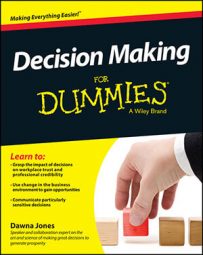Being clear on why you are taking action guides implementation. Establishing purpose (the why) is a must-do, front-end task because, when you know why you’re doing something, you reduce the risk of mistakes and misunderstandings when circumstances change. Purpose provides the focus for thinking, action, and all the micro-decisions that lead to the result.
Identifying the reason for the decision
Decisions are made for several reasons. In business, the two most common reasons for making a decision and taking action are to address a problem or to seize an opportunity:
Solving a problem: Operationally, when equipment isn’t working, products aren’t delivered on time, or customers don’t receive what they ordered when you promised it, it’s a problem. When problems occur, you need to take action to find out why the problem exists.
In a flower shop, for example, having the fridge that supposed to store today’s shipment break down and not having a backup is a problem. The question is, is this simply a mechanical glitch or is the situation far more serious?
Seizing an opportunity: Opportunities take many forms: a serendipitous encounter with someone who has the potential to become your biggest buyer, for example, or a change in zoning laws in an area where you want to expand.
Other opportunities come dressed as problems: Employee disengagement, for example, is an opportunity to create a better workplace. Recognizing opportunities means seeing situations like these not as problems to be solved, but as a chance to do things differently.
When the reason for making the decision is clarified, being super clear about what you are hoping to achieve (the outcome or result) provides the focus for getting there. Make sure you can articulate the following:
Why you’re taking action now and not later
What will be in place when the action plan is complete
What conditions you want the solution to meet
Providing a compelling picture of the desired outcome mobilizes the minds and hearts of employees and other affected parties.
Taking a tactical or strategic approach
Actions can be propelled by urgency (you need to do something fast) or inspired by vision and opportunity in the longer term. Articulating what you want the decision to achieve gives you a good idea about whether you need to take a tactical or strategic approach.
To understand the difference between strategic and tactical actions, consider this situation: The workload at your company has become intolerable, and your employees are stressed and requesting overtime pay. In addressing the problem, you can take a tactical approach or a strategic approach:
Tactical: You look at options that solve the immediate problem, like outsourcing some of the work or hiring someone to alleviate the burden on your employees.
Strategic: You step back to observe how work is being delegated and communicated, how existing resources are being used, and so on, so that you can discover and address what is creating the pressure in the first place. With this knowledge, you can institute changes that in the long run will reduce employees’ stress and workload.
It’s easy to make the pain go away by taking action quickly before you truly understand the situation. Doing so can result in having to revisit the problem when the solution proves to be ineffective. Companies, for example, sometimes fix undesirable employee behavior by sending them off to training rather than exploring what is creating the situation in the system (culture) itself.

